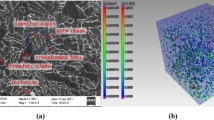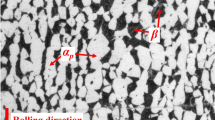Abstract
To study the stress state of TC16 under different cold forming, to avoid the fracture of TC16 titanium alloy during cold forging. Cold compression, cold tension and cold torsion experiments were carried out on it under different stress states. The fracture strain values and stress–strain relationship under different stress triaxial ratios and normalized Lode's angle at different strain rates were obtained through these experiments. The data obtained from these experiments were constructed using Bai's model. Then, based on the physical evolution mechanism of dislocation density and fracture strain, a new set of coupled ductile damage constitutive equations was proposed using the internal state variable modeling method. To simulate the microscopic damage evolution during cold forming of TC16 alloy. The unknown parameters within the unified constitutive equation are calculated by using an evolutionary algorithm optimization method. The experimental results show that there is a small gap between the values obtained by the proposed damage constitutive equation and the values obtained by the experiment, which shows the superiority of the proposed damage constitutive equation. After importing it into DEFORM-3D software through a subroutine, the distribution and evolution of micro-damage of bars with different notch radii during cold drawing are predicted. The finite element simulation further verifies the validity and accuracy of the prediction of the coupled ductile damage constitutive equation.


















Similar content being viewed by others
References
Z. Pater, J. Tomczak, and T. Bulzak, Analysis of a Cross Wedge Rolling Process for Producing Drive Shafts, Int. J. Adv. Manuf. Technol., 2018, 94, p 1–9.
J. Lin, Materials and Process Modelling in Metal Forming Applications, 2015.
Y. Lou, J.W. Yoon, and H. Huh, Modeling of shear ductile fracture considering a changeable cut-off value for stress triaxiality, in: AIP Conference Proceedings American Institute of Physics, 2014.
T.S. Cao, Models for Ductile Damage and Fracture Prediction in Cold Bulk Metal Forming Processes: A Review, Int.J. Mater. Form., 2017, 10, p 139–171.
M. Brünig, S. Gerke, and V. Hagenbrock, Stress-State-Dependence of Damage Strain Rate Tensors Caused by Growth and Coalescence of Micro-Defects, Int. J. Plast, 2014, 63, p 49–63.
M. Brünig, D. Brenner, and S. Gerke, Stress State Dependence of Ductile Damage and Fracture Behavior: Experiments and Numerical Simulations, Eng. Fract. Mech., 2015, 141, p 152–169.
L.F. Peng, Z.T. Xu, M.W. Fu, and X.M. Lai, Forming Limit of Sheet Metals in Meso-Scale Plastic Forming by Using Different Failure Criteria, Int. J. Mech. Sci., 2016, 120, p 190–203.
M.G. Cockcroft and D.J. Latham, Ductility and the Workability of Metals, J. Inst. Met., 1968, 96, p 33–39.
J.R. Rice and D.M. Tracey, on the ductile enlargement of voids in triaxual stress fields, J. Mech. Phsicas Solids, 1969, 17, p 201–217.
P. Brozzo, B. Deluca, and R. Rendina, A new method for the prediction of formability in metal sheets, in: Proceedings of the 7th Biennial conference of IDDRG on sheet metal forming and formability, 1972.
Y. Bai and T. Wierzbicki, A New Model of Metal Plasticity and Fracture with Pressure and Lode Dependence, Int. J. Plast, 2008, 24, p 1071–1096.
L. Xue and T. Wierzbicki, Ductile Fracture Characterization of Aluminum Alloy 2024–T351 Using Damage Plasticity Theory, Int. J. Appl. Mech., 2009, 01, p 267–304.
Y. Lou and H. Huh, Prediction of Ductile Fracture for Advanced High Strength Steel with a New Criterion: Experiments and Simulation, J. Mater. Process. Tech, 2013, 213, p 1284–1302.
A.L. Gurson, Continuum Theory of Ductile Rupture by Void Nucleation and Growth: Part I—Yield Criteria and Flow Rules for Porous Ductile Media, J. Eng. Mater. Technol., 1977, 99, p 2.
V. Tvergaard and A. Needleman, Analysis of the Cup-Cone Fracture in a Round Tensile Bar, Acta Metall., 1984, 32, p 157–169.
P.G. Kossakowski, The Influence of Microstructural Defects on the Stress State of S235JR Steel under Plastic Deformation, Solid State Phenom., 2016, 250, p 69–76.
M.E. Torki, S.M. Keralavarma, and A.A. Benzerga, An Analysis of Lode Effects in Ductile Failure, J. Mech. Phys. Solids, 2021, 153, 104468.
K. Nahshon and J.W. Hutchinson, Modification of the Gurson Model for Shear Failure, Eur. J. Mech., 2008, 27, p 1–17.
K.L. Nielsen and V. Tvergaard, Effect of a Shear Modified Gurson Model on Damage Development in a FSW Tensile Specimen, Int. J. Solids Struct., 2009, 46, p 587–601.
L.M. Kachanov and D. Krajcinovic, Introduction to Continuum Damage Mechanics, J. Appl. Mech., 1987, 54, p 481.
J. Lemaitre and J.L. Chaboche, Mechanics of solid materials || Damage mechanics, Cambridge University Press, 1990, p 346–450
J.X. Wang and A.N. Jiang, Integration Algorithm for Isotropic Hardening Using Lemaitre's Coupled Elastoplastic Damage Model and Program Implementation, Eng. Mech., 2015, 20–27.
M. Brünig and A. Michalski, A Stress-State-Dependent Continuum Damage Model for Concrete Based on Irreversible Thermodynamics, Int. J. Plast, 2016, 90, p 31–43.
M. Brünig, A Continuum Damage Model Based on Experiments and Numerical Simulations—A Review, Springer International Publishing, 2015.
M. Brünig, M. Schmidt, and S. Gerke, Numerical Analysis of Stress-State-Dependent Damage and Failure Behavior of Ductile Steel Based on Biaxial Experiments, Comput. Mech., 2020 https://doi.org/10.1007/s00466-020-01932-z
T. Wierzbicki, Y. Bao, Y.-W. Lee, and Y. Bai, Calibration and Evaluation of Seven Fracture Models, Int. J. Mech. Sci., 2005, 47, p 719–743.
H. Traphner, T. Clausmeyer, and A.E. Tekkaya, Methods for Measuring Large Shear Strains in in-Plane Torsion Tests, J. Mater. Process. Technol., 2019 https://doi.org/10.1016/j.jmatprotec.2019.116516
M. Dunand and D. Mohr, Optimized Butterfly Specimen for the Fracture Testing of Sheet Materials Under Combined Normal and Shear Loading—ScienceDirect, Eng. Fract. Mech., 2011, 78, p 2919–2934.
L. Morin, J.B. Leblond, D. Mohr, and D. Kondo, Prediction of Shear-Dominated Ductile Fracture in a Butterfly Specimen Using a Model of Plastic Porous Solids Including Void Shape Effects, Eur. J. Mech. A Solids, 2017, 61, p 433–442.
B. Huang, X. Miao, X. Luo, Y. Yang, and Y. Zhang, Microstructure and Texture Evolution Near the Adiabatic Shear Band (ASB) in TC17 TITANIUM Alloy with Starting Equiaxed Microstructure Studied by EBSD, Mater. Charact., 2019, 151, p 151–165.
Q. Xue, Y.J. Ma, J.F. Lei, R. Yang, and C. Wang, Evolution of Microstructure and Phase Composition of Ti-3Al-5Mo-4.5V Alloy with Varied β Phase Stability, J. Mater. Sci. Technol., 2018, 34, p 103–108.
T.S. Cao, M. Mazière, K. Danas, and J. Besson, A Model for Ductile Damage Prediction at Low Stress Triaxialities Incorporating Void Shape Change and Void Rotation, Int. J. Solids Struct., 2015, 63, p 240–263.
F.Q. Gu and H.L. Liu, A Novel Weight Design in Multi-objective Evolutionary Algorithm, in: 2010 International Conference on Computational Intelligence and Security, CIS 2010, Nanning, Guangxi Zhuang Autonomous Region, China, December 11–14, 2010, 2010.
J. Lin, B.H. Cheong, and X. Yao, Universal Multi-Objective Function for Optimising Superplastic-Damage Constitutive Equations, J. Mater. Process. Technol., 2002, 125–126, p 199–205.
J. Lin and T.A. Dean, Modelling of Microstructure Evolution in Hot Forming Using Unified Constitutive Equations, J. Mater. Process. Technol., 2005, 167, p 354–362.
L. Yang, B. Wang, G. Liu, H. Zhao, and W. Xiao, Behavior and Modeling of Flow Softening and Ductile Damage Evolution in Hot Forming of TA15 Alloy Sheets, Mater. Des., 2015, 85, p 135–148.
Y. Huo, J. Lin, Q. Bai, B. Wang, and H. Ji, Prediction of Microstructure and Ductile Damage of a High-Speed Railway Axle Steel during Cross Wedge Rolling, J. Mater. Process. Technol., 2017, 239, p 359–369.
Y. Liu, J. Lin, T.A. Dean, and D.C.J. Farrugia, A Numerical and Experimental Study of Cavitation in a Hot Tensile Axisymmetric Testpiece, J. Strain Anal. Eng. Des., 2005, 40, p 571–586.
Y. Bai and T. Wierzbicki, A Comparative Study of Three Groups of Ductile Fracture Loci in the 3D Space, Eng. Fract. Mech., 2015, 135, p 147–167.
B. Li, J. Lin and X. Yao, A Novel Evolutionary Algorithm for Determining Uniÿed Creep Damage Constitutive Equations, Int. J. Mech. Sci., 2002, 44, p 987–1002.
Acknowledgments
This project is funded by the National Natural Science Foundation of China (Grant No. 51805314), Key Technologies Research and Development Program (Grant No. 2018YFB1307900) and Shanghai Association for Science and Technology (Grant No. 16030501200).
Author information
Authors and Affiliations
Corresponding author
Ethics declarations
Conflict of interest
The authors declare that they have no conflict of interest.
Additional information
Publisher's Note
Springer Nature remains neutral with regard to jurisdictional claims in published maps and institutional affiliations.
Rights and permissions
About this article
Cite this article
Huo, Y., Yang, W., He, T. et al. A Novel Unified Visco-Plastic Damage Constitutive Model Considering Stress State of TC16 Titanium Alloy during Cold Deformation. J. of Materi Eng and Perform 32, 4522–4540 (2023). https://doi.org/10.1007/s11665-022-07415-x
Received:
Revised:
Accepted:
Published:
Issue Date:
DOI: https://doi.org/10.1007/s11665-022-07415-x




